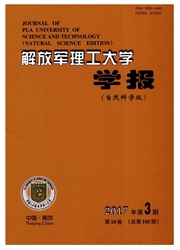

 中文摘要:
中文摘要:
有三个发辫酒吧的一条多支流河是在自然的一个典型的河模式,但是没有研究被进行了描述在河里混合污染物质的特征。在这研究,有三个发辫酒吧的一条典型多支流河的一个物理模型被建立探索在不同分支混合特征的污染物质。多支流活动范围被分开成七个分支, B1, B2, B3, B4, B5, B6,和 B7,由三个发辫酒吧。五个 tracer 版本位置定位了从多支流活动范围的入口节在上游的 2.9 m 被采用,并且到在上游的主要隧道的左河岸的从五个位置的距离是 1/6B , 1/3B , 1/2B , 2/3B ,并且 5/6B ( B 是在上游的主要隧道的宽度)分别地。在七个分支的纵的速度和污染物质集中被测量。平面流动领域和到多支流河里的表面的从底部的污染物质的混合特征被获得并且分析。污染物质版本位置是在污染物质运输过程的主要影响因素的结果表演,和转向点和污染物质联合释放位置在在上游的主要隧道在分支 B1, B2,和 B3 影响污染物质流动的百分比比率到污染物质流动。
 英文摘要:
英文摘要:
A multi-anabranch river with three braid bars is a typical river pattern in nature, but no studies have been conducted to describe mixing characteristics of pollutants in the river. In this study, a physical model of a typical multi-anabranch river with three braid bars was established to explore the pollutant mixing characteristics in different branches. The multi-anabranch reach was separated into seven branches, B1, B2, B3, B4, B5, B6, and BT, by three braid bars. Five tracer release positions located 2.9 m upstream from the inlet section of the multi-anabranch reach were adopted, and the distances from the five positions to the left bank of the upstream main channel were 1/6B, 1/3B, 1/2B, 2/3B, and 5/6B (B is the width of the upstream main channel), respectively. The longitudinal velocities and pollutant concentrations in the seven branches were measured. The planar flow field and mixing characteristics of pollutants from the bottom to the surface in the multi-anabranch river were obtained and analyzed. The results show that the pollutant release positions are the main influencing factors in the pollutant transport process, and the diversion points and pollutant release positions jointly influence the percentage ratios of the pollutant fluxes in branches B 1, B2, and B3 to the pollutant flux in the upstream main channel.
 同期刊论文项目
同期刊论文项目
 同项目期刊论文
同项目期刊论文
 The effect of vegetation on sediment resuspension and phosphorus release under hydrodynamic disturba
The effect of vegetation on sediment resuspension and phosphorus release under hydrodynamic disturba Zero-valent nanophase iron and nitrogen co-modified titania nanotube arrays: Synthesis, characteriza
Zero-valent nanophase iron and nitrogen co-modified titania nanotube arrays: Synthesis, characteriza Self-assembly of different graphere-modified morphologies of Tio2: nanoparticle, nanorod and nanowir
Self-assembly of different graphere-modified morphologies of Tio2: nanoparticle, nanorod and nanowir Pollutant mixing and transport process via diverse transverse release positions in a multi-anabranch
Pollutant mixing and transport process via diverse transverse release positions in a multi-anabranch Flow Resistance and Velocity Structure in Shallow Lakes with Flexible Vegetation under Surface Shear
Flow Resistance and Velocity Structure in Shallow Lakes with Flexible Vegetation under Surface Shear Copper nanoparticles sensitized TiO2 nanotube arrays electrode with enhanced photoelectrocatalytic a
Copper nanoparticles sensitized TiO2 nanotube arrays electrode with enhanced photoelectrocatalytic a Multi-parameteridentification of a two-dimensional water-quality model based on theNelder-Mead Simpl
Multi-parameteridentification of a two-dimensional water-quality model based on theNelder-Mead Simpl β-Cyclodextrin inclusion complex as the immobilization matrix for laccase in the fabrication of a bi
β-Cyclodextrin inclusion complex as the immobilization matrix for laccase in the fabrication of a bi Heterogeneous Fenton degradation of bisphenol A catalyzed by efficient adsorptive Fe3O4/GO nanocompo
Heterogeneous Fenton degradation of bisphenol A catalyzed by efficient adsorptive Fe3O4/GO nanocompo 期刊信息
期刊信息
